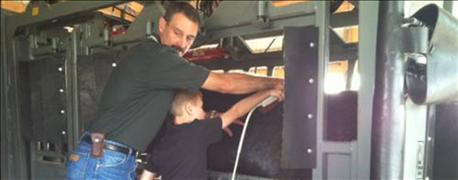February 18, 2016

Breeders can scan yearling bulls and heifers for carcass traits and have this information included in National Cattle Evaluation ultrasound EPDs. Ultrasound EPDs are equivalent to carcass EPDs and simple process offers a non-invasive way to collect this important information. Certified Ultrasound Technicians collect the images and send them to a centralize lab where the images are interpreted. Data is forwarded to a breed association to be included in breeding values.
Michigan State University (MSU) Extension has invested in ultrasound scanning locating a technician in central-Michigan. Contact me to discuss scanning options for your beef operation at [email protected] or call (616) 527-5357.

Ultrasound data can quickly improve your breeding herd
For a brochure of scanning services, you may visit the MSU Extension beef team website to find more information on the Beef Cattle Ultrasound Program. Scanning is fast and very affordable for producers.
Producer requirements:
•Schedule a date that coincides with your breed’s scanning age range (check with your association for the date ranges)
•Obtain an ultrasound “BARN SHEET” from your breed association for registered animals
•Weigh cattle at scanning time or within seven days of the scanning date
•Cattle need to be restrained in a safe and effective handling facility
•110V power is needed to operate scanning equipment
What the cattle breeder and feeder receives:
•After scanning, the measurements are forwarded to the CUP Lab for interpretations and then results are sent to the appropriate breed association. Ultrasound record processing follows the same format used for weight traits within performance programs. Breeders receive the ultrasound measurements (adjusted EPD’s and contemporary group ratios) as a part of the program for all measured traits.
•Ultrasound measures are adjusted to 365 days of age for yearling bulls. The current age end point adjustments for developing heifers is 390 days of age. The end-point adjustments for feedlot steers and heifers is 420 days of age.
Scan information is measured for each animal for the following;
•12-13th rib fat thickness
•Ribeye area
•Percentage intramuscular fat (marbling)
•Rump fat thickness (Angus and Maine-Anjou)
Feedlot or fair cattle can also be scanned to capture carcass data prior to harvest
It’s that time of year when yearling ultrasound data need to be collected for winter and spring calving herds. If you are serious about improving your carcass traits of your herd over time, you should consider ultrasound data collection as an important genetic management tool that provides marketing data for your operation.
Ultrasound information outlining beef industry trends and scanning values for individual herds is available at the CUP Lab website.
Gould writes for Michigan State University Extension
You May Also Like




